If you have ever grown Calathea plants, you know that they are finicky. One of the most common problems with Calathea is white spots on the leaves. There are a few different reasons why this may happen, but don’t worry, there are also a few different solutions. In this article, we will discuss six different causes of white spots on Calathea leaves and how to fix them.
White Crystals on Calathea Leaves
If your Calathea is getting too much sunlight, move it to a spot that gets less sun. One of the most common problems with Calathea plants is white spots on the leaves. These spots can be caused by a number of different things, but the most common cause is too much sunlight.
Another common cause of white spots on Calathea leaves is too much water. If you think your plant is getting too much water, try letting the soil dry out a bit before watering again.
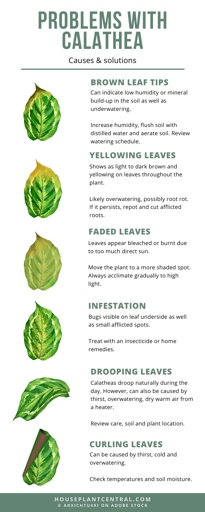
If you can’t figure out what’s causing the white spots on your Calathea’s leaves, take a sample of the affected leaves to your local nursery or garden center for help.
Solution
If you’re noticing white spots on your Calathea leaves, don’t worry—it’s a common issue that has several easy solutions.
To fix this, simply flush the leaves with distilled water or rainwater to remove any excess minerals. One of the most common causes of white spots on Calathea leaves is mineral build-up from hard water.
You can also try using a natural remedy like neem oil. If your white spots are caused by spider mites, you’ll need to treat the plant with an insecticide.
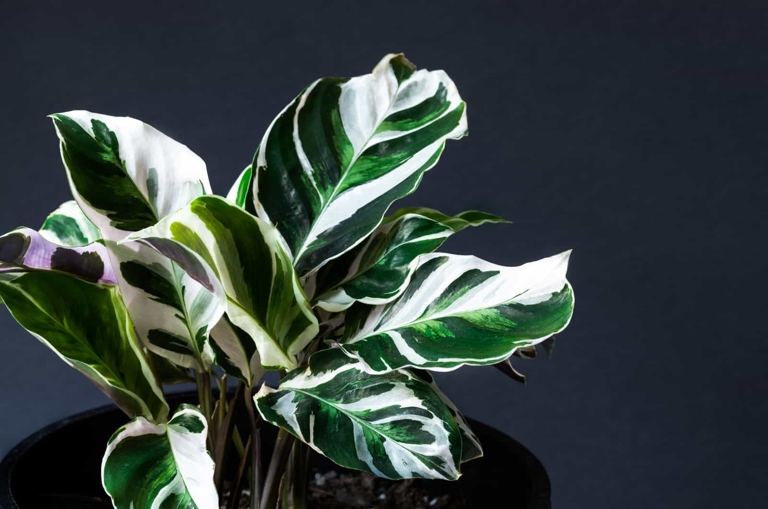
If the spots are caused by too much sun exposure, simply move your plant to a shadier spot. If the spots are the result of too much water, allow the soil to dry out completely between watering.
With a little troubleshooting, you should be able to get rid of those white spots on your Calathea leaves in no time!
Pest Infestation
If you have white spots on your Calathea leaves, it’s likely due to a pest infestation. These pests suck the sap from the leaves, causing them to turn yellow and eventually die. The most common pests that attack Calathea are mealybugs, spider mites, and scale insects.
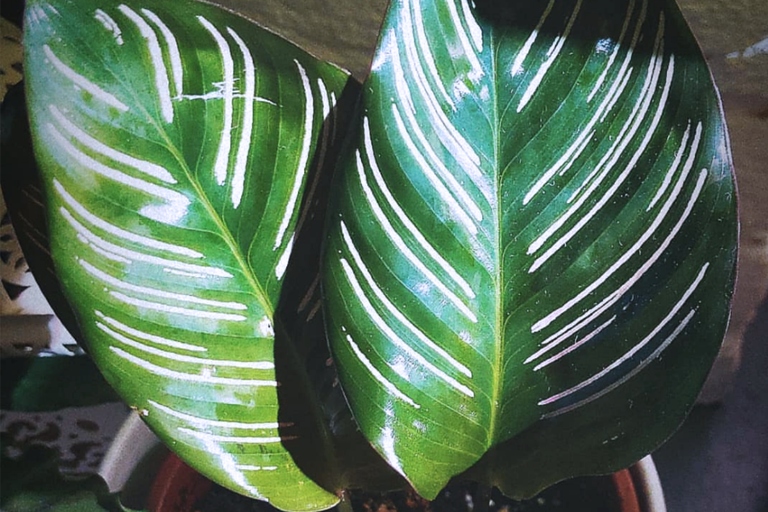
Then, treat your plant with an insecticidal soap or neem oil. Be sure to follow the instructions on the label, as these products can be harmful to humans if used incorrectly. To get rid of pests, start by spraying your plant with water to dislodge them.
However, with proper treatment, your Calathea should recover and continue to thrive. If your infestation is severe, you may need to dispose of heavily infested leaves.
Mealybugs
Mealybugs can cause damage to leaves and stems, and can even kill a plant if they are not controlled. They are small, white, wingless insects that feed on the sap of plants. Mealybugs are one of the most common houseplant pests.
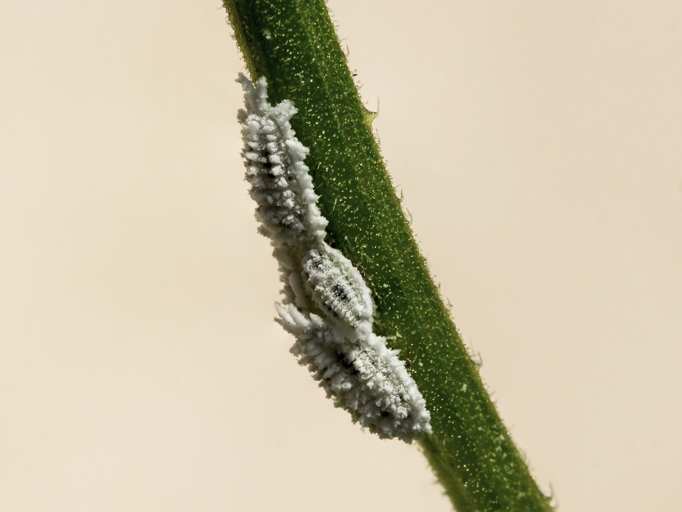
Mealybugs excrete a sticky substance called honeydew, which can attract other pests, such as ants. Mealybugs are most often found on the undersides of leaves, where they suck the sap from the plant. They can also be found on stems and in the crevices of leaves.
Mealybugs can be controlled with insecticidal soap or horticultural oil. These products must be applied directly to the mealybugs to be effective.
Spider Mite
These tiny pests are difficult to see with the naked eye, but they leave behind telltale signs of their presence in the form of white spots on the leaves of the plant. Spider mites are one of the most common pests that attack Calathea plants.

In severe cases, an infestation of spider mites can kill a Calathea plant. Spider mites feed on the sap of the plant, and their feeding can cause the leaves to turn yellow and eventually drop off.
One is to spray the plant with a strong stream of water to knock the spider mites off. Another is to apply a pesticide that is specifically designed to kill spider mites. There are a few things that you can do to get rid of spider mites on your Calathea plant.
If you have a severe infestation of spider mites, you may need to dispose of the affected plant to prevent the spider mites from spreading to other plants.
White Scale
Honeydew can attract other insects, as well as mold. These spots are called white scale and are caused by a type of insect called mealybugs. Mealybugs are small, white, wingless insects that feed on the sap of plants. They can be found in the crevices of leaves and stems, and they excrete a sticky substance called honeydew. If you have Calathea in your home, you may have noticed small white spots on the leaves.
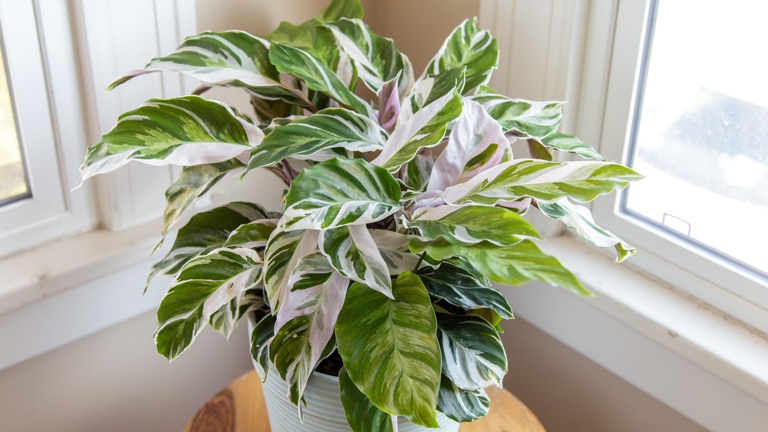
Be sure to follow the directions on the label and apply the product when the temperature is cool, such as in the evening. You may need to treat your plant multiple times to get rid of all the scale. White scale can be controlled with regular applications of insecticidal soap or horticultural oil.
Thrips
While thrips are not harmful to humans, they can cause damage to plants. If you have calathea in your home, you may have noticed small white spots on the leaves. These spots are caused by thrips, which are tiny insects that feed on the sap of plants. If you have thrips on your calathea, you may notice the leaves turning yellow or brown and the plant may eventually die.
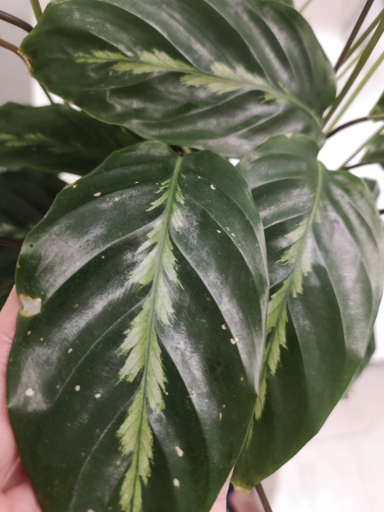
If the infestation is severe, you may need to throw out the plant and start over with a new one. You can try spraying the plant with water to dislodge the insects. There are a few things you can do to get rid of thrips. You can also try using a pesticide that is specifically designed to kill thrips.
You should also inspect the plant regularly for signs of pests. To prevent thrips from infesting your calathea, it’s important to keep the plant healthy. Make sure you’re watering it regularly and giving it the proper amount of light. If you see any, be sure to remove them immediately.
How to Get Rid of Insects on Calathea
If you have insects on your Calathea, don’t worry! There are a few things you can do to get rid of them.
First, try spraying your plant with a mixture of water and dish soap. This will kill most insects on contact.
If that doesn’t work, you can try a more powerful insecticide. Just be sure to follow the directions on the label carefully, as you don’t want to damage your plant.
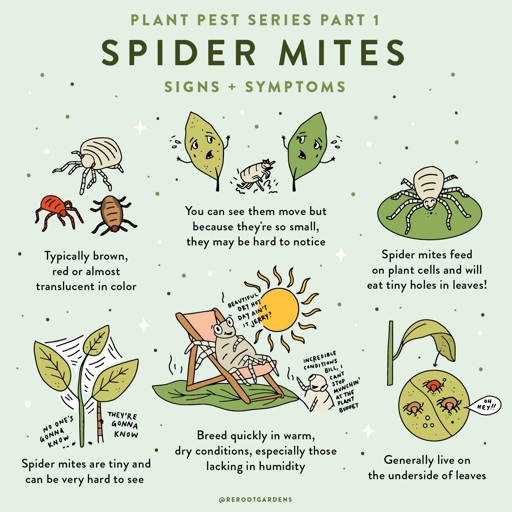
Finally, if all else fails, you can always bring your plant to a professional for help. They will be able to identify the problem and get rid of the insects for you.
Fungal Diseases
These diseases can cause the leaves of the plant to turn yellow or brown, and can eventually lead to the death of the plant. If you think that your plant has a fungal disease, you should contact a professional for help. Fungal diseases are one of the most common problems that can affect Calathea plants. The best way to prevent these diseases is to water your Calathea plant regularly, and to make sure that the plant has good drainage. There are several different types of fungi that can cause these diseases, and they can be difficult to control.
Powdery Mildew
While this problem is not fatal to the plant, it can cause the leaves to become discolored and distorted. If powdery mildew does develop, it can be treated with a fungicide. Powdery mildew is a type of fungus that can affect Calathea leaves, causing them to develop white spots. The best way to prevent powdery mildew is to keep the leaves dry and to provide good air circulation around the plant. Powdery mildew is most commonly caused by too much moisture or humidity in the air.
Solution
If you think this might be the problem, try moving your plant to a shadier spot. Calathea are native to tropical regions and do not do well in direct sunlight. The most likely cause of white spots on Calathea leaves is direct sunlight. If you’re noticing white spots on your Calathea leaves, don’t worry—it’s a common issue that has an easy fix.
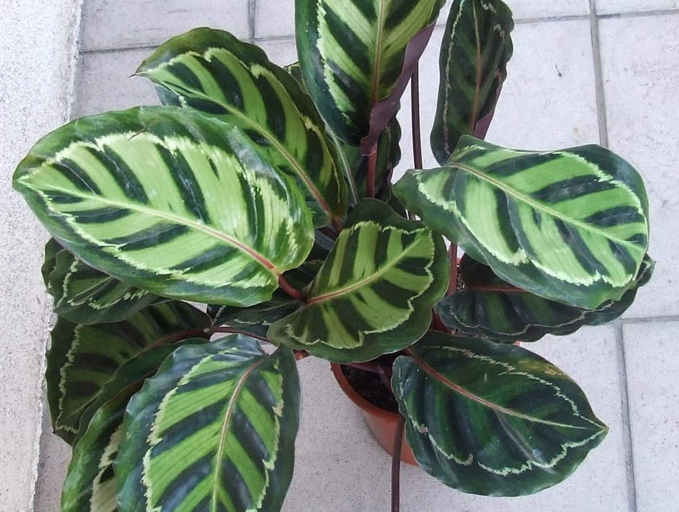
If you have hard water, try using distilled water or rainwater to water your plant. Another common cause of white spots on Calathea leaves is mineral build-up from hard water. You can also try wiping the leaves down with a damp cloth to remove any mineral deposits.
Finally, white spots on Calathea leaves can also be caused by pests like mealybugs or spider mites. If you see any pests on your plant, be sure to remove them immediately. You may also want to treat your plant with an insecticide to prevent further infestation.
White Mold (Saprophytic fungus)
This fungus is often found in humid environments and can spread quickly if not treated. While white mold is not typically harmful to humans, it can cause leaf spot disease in plants. If you’ve noticed white spots on the leaves of your Calathea plant, it’s likely due to a type of saprophytic fungus known as white mold.
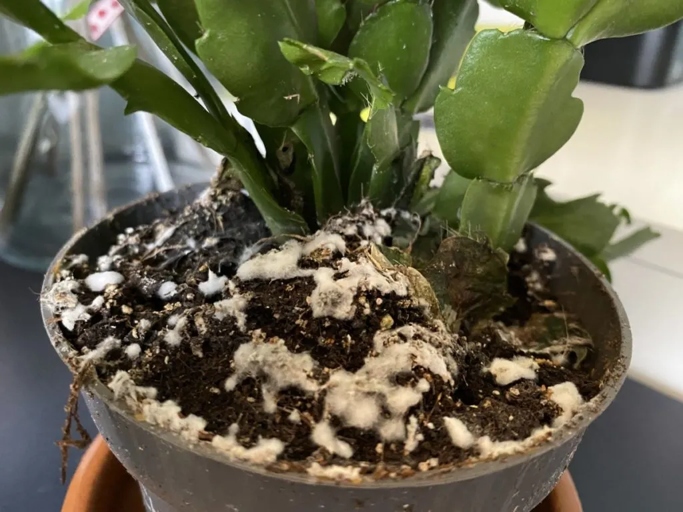
You should also avoid overhead watering, as this can promote the growth of the fungus. If you do notice white mold on your plant, you can remove affected leaves and treat the plant with a fungicide. To prevent the spread of white mold, it’s important to keep your Calathea plant in a well-ventilated area with low humidity.
Solution
If you’re noticing white spots on your Calathea leaves, don’t worry—it’s a common issue that has several easy solutions.
One of the most common causes of white spots on Calathea leaves is direct sunlight. These plants are native to the shady rainforests of Brazil, so they’re not used to strong sunlight. If your plant is getting too much sun, you’ll see white spots or bleached patches on the leaves.
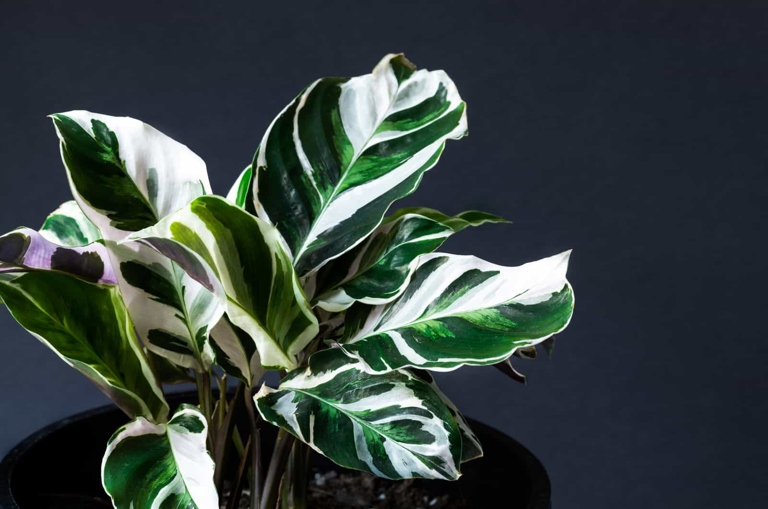
If it’s not getting enough light, you’ll see the opposite problem: brown spots on the leaves. The solution is simple: move your plant to a shadier spot.
Another common problem is mineral build-up from hard water. If you notice white spots or streaks on the leaves, it’s a good idea to start using distilled or filtered water for your plant.
Finally, white spots can also be a sign of mealybugs or other pests. These tiny insects suck the sap out of plants, causing damage and discoloration. If you think you have a pest problem, you can try using an insecticidal soap or horticultural oil.
Gray mold (Botrytis)
The best way to control gray mold is to keep the plant in a well-ventilated area and to water it only when the soil is dry. Gray mold (Botrytis) can be a problem for Calathea plants. If the mold is already present, you can remove it with a cotton swab dipped in rubbing alcohol. The mold can cause the leaves to turn brown and die.
Solution
There are a few possible causes and solutions. If you’re noticing white spots on your Calathea leaves, don’t fret!
One common cause of white spots on Calathea leaves is mineral build-up from hard water. To solve this problem, simply flush the leaves with clean water to remove any deposits.
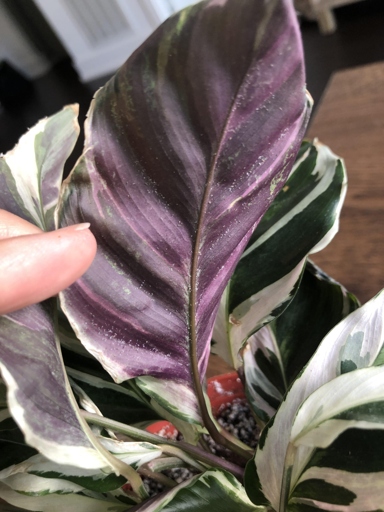
If your plant is getting too much direct sunlight, the leaves may develop white spots as well. Move your plant to a location with indirect or filtered light to prevent further damage.
Finally, white spots can also be a sign of pests. If you see any insects on your plant, be sure to remove them promptly. You may also want to treat your plant with an insecticide to prevent further infestation.
Nitrogen Deficiency Cause White Patches on Leaves
Nitrogen is an essential nutrient for plants, and a lack of it can cause a number of problems, including yellowing leaves, stunted growth, and leaf drop. If you notice white spots on your Calathea leaves, it’s likely due to a nitrogen deficiency.
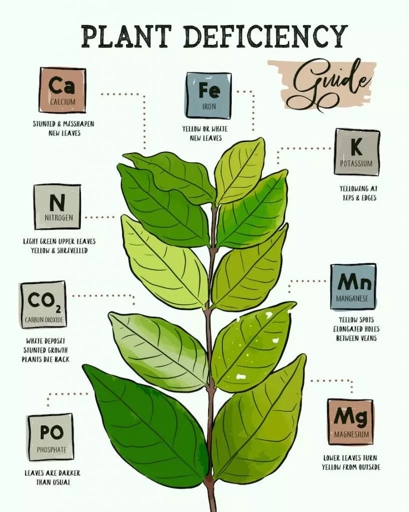
Be sure to water your plant regularly, as a lack of water can also cause a nitrogen deficiency. To correct a nitrogen deficiency, fertilize your plant with a nitrogen-rich fertilizer. You can also add compost or manure to your plant’s soil to boost its nitrogen content.
Sunburn Cause the Leaves to Appear White
But what if your Calathea leaves start to turn white? It could be a sign of sunburn. Calathea leaves are known for their beautiful, vibrant colors.
This is because the leaves are not able to tolerate the intense heat and light from the sun. When Calathea leaves are exposed to direct sunlight, the leaves can start to turn white. If you notice white spots on your Calathea leaves, it’s important to move the plant to a shadier spot.
If the sunburn is severe, the leaves may turn brown and eventually die. To prevent this, make sure to give your Calathea plant plenty of water. The extra moisture will help the plant recover from the sunburn.
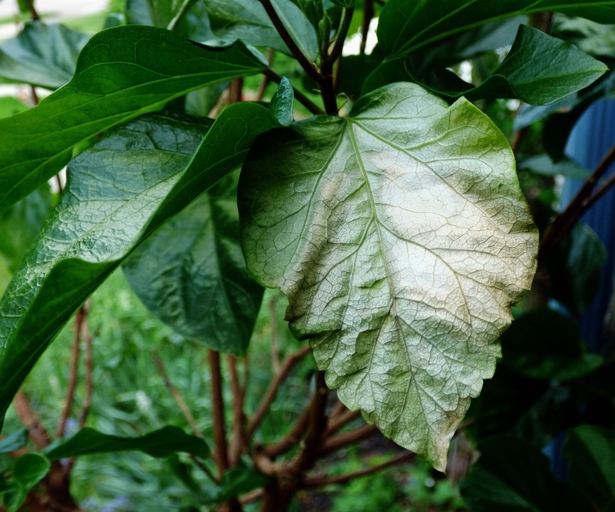
If you see white spots on your Calathea leaves, it’s important to take action right away. By moving the plant to a shadier spot and increasing the water, you can help your Calathea plant recover from sunburn.
Edema Makes the Leaf Appear Blistered
It is caused by a build-up of water in the leaves, and is often the result of too much water being given to the plant. Overwatering is the most common cause of edema, so it is important to be careful not to water your Calathea too often. Edema is a condition that causes the leaves of a Calathea to appear blistered. If you see the leaves of your plant beginning to blister, you can reduce the amount of water you give it and allow the soil to dry out more between waterings.
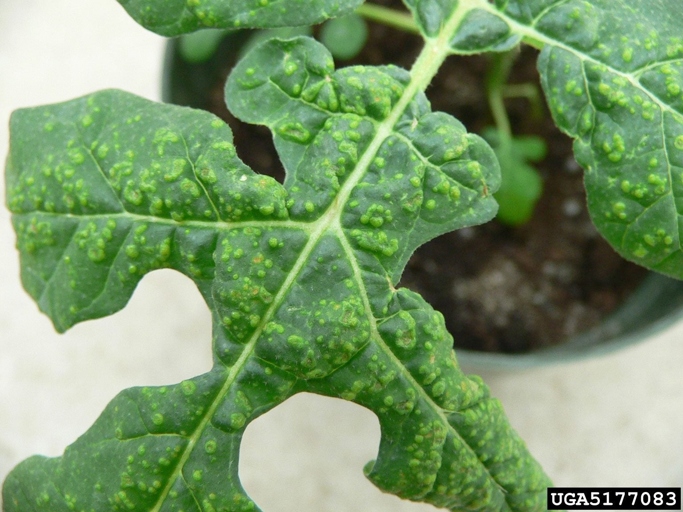
If you notice edema on your plant, be sure to adjust your watering schedule and make sure the plant is not getting too much water. With proper care, your Calathea will soon be looking healthy and green again. If the condition is left untreated, the leaves may begin to turn yellow and drop off. Edema is not harmful to your Calathea, but it can be unsightly.
Solution
The most common cause of white spots on Calathea leaves is direct sunlight. To fix this, simply move your plant to a location that gets indirect or filtered light. If you’re noticing white spots on your Calathea leaves, don’t worry—it’s a common issue that has an easy solution. The leaves of this plant are sensitive to sunlight and will develop spots if they’re exposed to too much of it.

These spots will eventually fade on their own, so there’s no need to do anything. However, if the spots are large and brown, they could be a sign of a fungal infection. If the spots on your Calathea leaves are small and white, they’re probably just sunburns. If this is the case, you’ll need to treat the plant with a fungicide.
Once you’ve identified the cause of the white spots on your Calathea leaves, it’s easy to find a solution. With a little care, your plant will be healthy and beautiful in no time.
Frequently Asked Questions
1. What are white spots on Calathea leaves?
2. What are the causes of white spots on Calathea leaves?
3. How can I prevent white spots on Calathea leaves?
4. What is the best way to treat white spots on Calathea leaves?
5. How can I remove white spots from Calathea leaves?
1. White spots on Calathea leaves are usually caused by one of six things: sun damage, pests, mineral build-up, too much water, too little water, or chemicals in the water.
2. Sun damage is the most common cause of white spots on Calathea leaves. The spots are usually white or pale yellow and are more prevalent on the leaves that get the most sun exposure.
3. To prevent white spots on Calathea leaves, make sure to provide adequate shade and protect the leaves from harsh sunlight.
4. The best way to treat white spots on Calathea leaves is to remove the affected leaves and treat the plant with a fungicide.
5. To remove white spots from Calathea leaves, gently rub the spots with a soft cloth soaked in soapy water.
Final thoughts
If you have white spots on your Calathea leaves, it is most likely due to one of these six causes. But don’t worry, there are solutions for each problem. With a little bit of care, your Calathea will be healthy and beautiful in no time.
